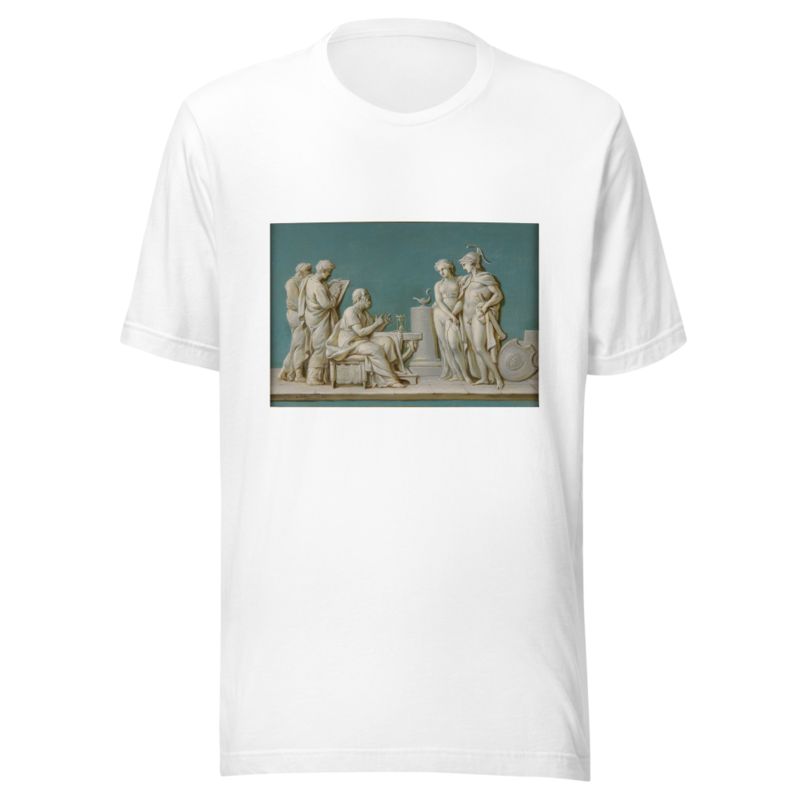Description
Socrate instruisant la jeunesse by Jean-Simon Berthélemy printed on a T-Shirt
About the T-Shirt
Regular fit
Standard length, the fabric easily gives into movement
Casual wear
A classic, everyday option loved by our customers
Side-seamed
Constructed by sewing two parts together, creating a fitted look
The Unisex Staple T-Shirt feels soft and light with just the right amount of stretch. It’s comfortable and flattering for all. We can’t compliment this shirt enough–it’s one of our crowd favorites, and it’s sure to be your next favorite too!
- Solid colors are 100% Airlume combed and ring-spun cotton
- Ash color is 99% combed and ring-spun cotton, 1% polyester
- Heather colors are 52% combed and ring-spun cotton, 48% polyester
- Athletic and Black Heather are 90% combed and ring-spun cotton, 10% polyester
- Heather Prism colors are 99% combed and ring-spun cotton, 1% polyester
- Fabric weight: 4.2 oz./yd.² (142 g/m²)
- Pre-shrunk fabric
- 30 singles
- Side-seamed construction
- Tear-away label
- Shoulder-to-shoulder taping
- Blank product sourced from Nicaragua, Mexico, Honduras, or the US
Jean-Simon Berthélemy (1743 – 1811)
Jean-Simon Berthélemy was a French history painter who was commissioned to paint allegorical ceilings for the Palais du Louvre, the Luxembourg Palace and others, in a conservative Late Baroque-Rococo manner only somewhat affected by Neoclassicism.
Berthélemy was born in Laon, Aisne, the son of a sculptor, Jean-Joseph Berthélemy,. He trained in the atelier of Noël Hallé, a professor at the Académie royale de peinture et de sculpture and made his first reputation in the 1760s; after reaching second place in 1763, he won the Prix de Rome of the Académie in 1767. An early commission was for a suite of decorative paintings under the direction of the architect Jean-Gabriel Legendre for the Hôtel de l’Intendance de Champagne at Châlons-sur-Marne, of which the artist only completed six overdoors, much in the manner of François Boucher, and delegated the rest of the commission to a fellow pupil at the Académie.
Berthélemy’s master Hallé provided cartoons for the royal tapestry manufacture of the Gobelins, where he was appointed superintendent in 1770; Berthélemy was called upon to provide cartoons for the weavers as well. His Death of Etienne Marcel (1783, on display in the École de Chirurgie) of which the oil sketch survives, was woven in the series Histoire de France.
Berthélemy was an esteemed painter in his day, chosen to join the entourage accompanying Napoleon’s campaign in Italy, where he was among the experts assigned the task of selecting works of art to be transferred to Paris under terms of the Treaty of Tolentino, February 1797. He died in Paris. When two monographs on Berthélemy were published in 1979, Philip Conisbee, reviewing them in The Burlington Magazine, observed drily: “Two monographs on Berthélemy is overkill for a painter who could have been dispatched with a single substantial article. The French academic system of art education in the eighteenth century, backed up by the stimulus of church and state patronage, was so efficient and rigorous that even an average talent could be sufficiently conditioned to produce a handful of decent history-paintings, which are sometimes minor masterpieces.”






Reviews
There are no reviews yet.